Cooking is an art and a science. It’s a dance of heat and ingredients, resulting in a symphony of flavors and textures.
One of the key players in this dance is dry heat. It’s a method that cooks by exposing food directly to hot air or a hot surface.
But what does it mean to cook by dry heat? How does it differ from other cooking methods?
This guide will delve into the world of dry heat cooking. We’ll explore the science behind heat transfer methods, the techniques involved, and the benefits it brings to your dishes.
Whether you’re a home cook, a culinary student, or a professional chef, this guide will provide valuable insights.
So, let’s embark on this culinary journey and master the art of cooking with dry heat.
Understanding Dry Heat Cooking
Dry heat cooking is a time-honored technique. It uses high temperatures to transform raw ingredients into delicious meals. This method requires direct exposure to heat, without relying on moisture.
One of the key elements in dry heat cooking is air circulation. This encourages even cooking and caramelization, which amplifies flavors.
Here are some of the most popular dry heat cooking techniques:
Baking: Cooking food in a dry heat oven, often with a leavening agent.
Roasting: Cooking food in an oven at high temperatures.
Grilling: Using direct, radiant heat, usually over a flame.
Sautéing: Cooking quickly in a small amount of oil or fat.
Broiling: Cooking with intense, direct heat from above.
Frying: Cooking food by submerging or partially submerging it in hot oil or fat.

What is Dry Heat Cooking?
Dry heat cooking involves methods like roasting, grilling, and frying. It doesn’t use water or broth, unlike moist cooking methods.
This technique is ideal for foods that benefit from a crispy exterior. Examples include meats and vegetables, where caramelization adds flavor.
One reason to love dry heat cooking is its ability to preserve nutrients. It often cooks quickly, locking in vitamins and minerals that might get lost in boiling.
The Science of Heat Transfer Methods
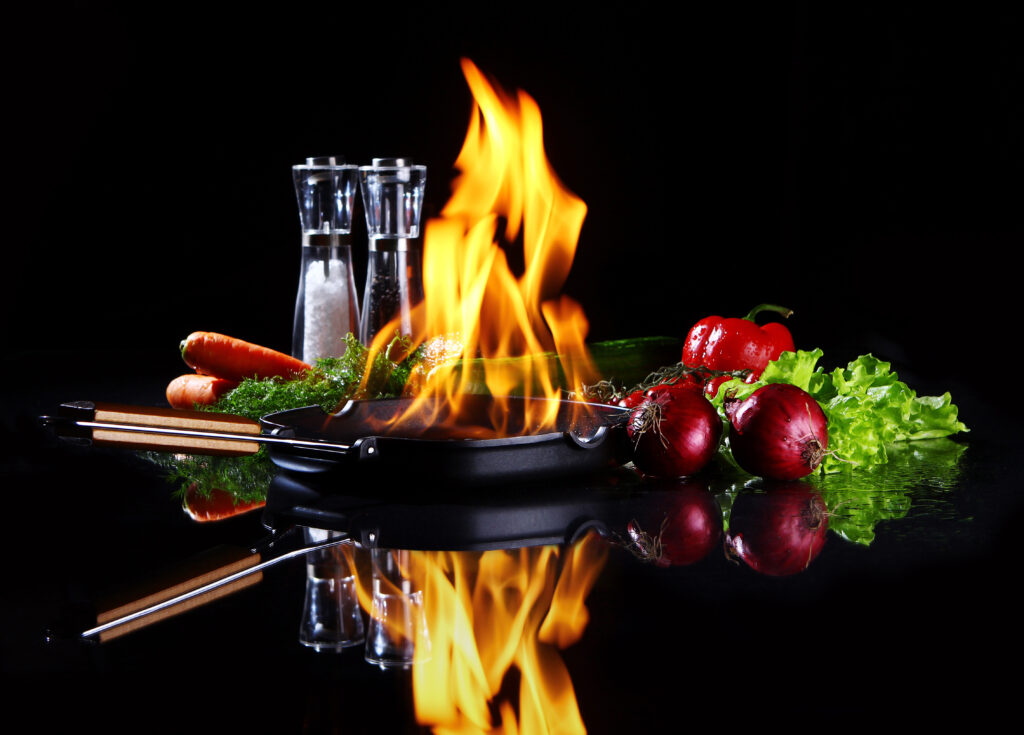
Heat transfer in cooking is about movement. It’s the process of thermal energy traveling from heat sources to food. There are three primary methods of heat transfer: conduction, convection, and radiation.
In dry heat cooking, these methods work together. Conduction heats food directly through contact with a hot surface. Meanwhile, convection circulates hot air around the food.
Radiation transfers heat energy directly from the source, like a grill or broiler. This combination results in even cooking and ideal textures.
Dry Heat vs. Moist Heat Cooking
Dry heat cooking and moist heat cooking both have their place in the kitchen. They cater to different culinary needs and provide varied results.
Dry heat methods are celebrated for creating rich, savory flavors. They excel at browning food, enhancing texture and taste without added liquids.
Moist heat, in contrast, relies on water or broth to cook food. It’s perfect for tenderizing and infusing with subtle flavors, as in simmering or steaming. Both cooking methods open a world of possibilities in culinary arts.
Benefits of Dry Heat Cooking
Cooking by dry heat offers a host of advantages. It enhances both the texture and taste of food. This method is particularly celebrated in the culinary world for its ability to lock in flavors.
One major benefit is the improved texture. Techniques like roasting and grilling create a desirable crust. This crust contrasts with tender interiors, delivering a satisfying mouthfeel.
Dry heat cooking also amplifies natural flavors. With higher temperatures, chemical reactions like the Maillard reaction occur. These enhance savory notes and develop rich, complex flavors.
Here are some specific benefits of dry heat cooking:
Flavor Intensification: High heat allows for caramelization and the Maillard reaction.
Texture Variety: Creates crispiness on the outside while keeping juiciness inside.
Nutrient Retention: Shorter cooking times preserve essential nutrients.
Versatility: Multiple techniques are applicable across various foods, from vegetables to meats.
These methods often require minimal fat. By using the food’s natural juices and concentrating flavors, you can create healthy, delicious dishes.
Finally, dry heat cooking fits seamlessly into modern cooking trends. From outdoor barbecues to weeknight meals, it’s a versatile approach. It’s well-suited for both casual and gourmet applications.
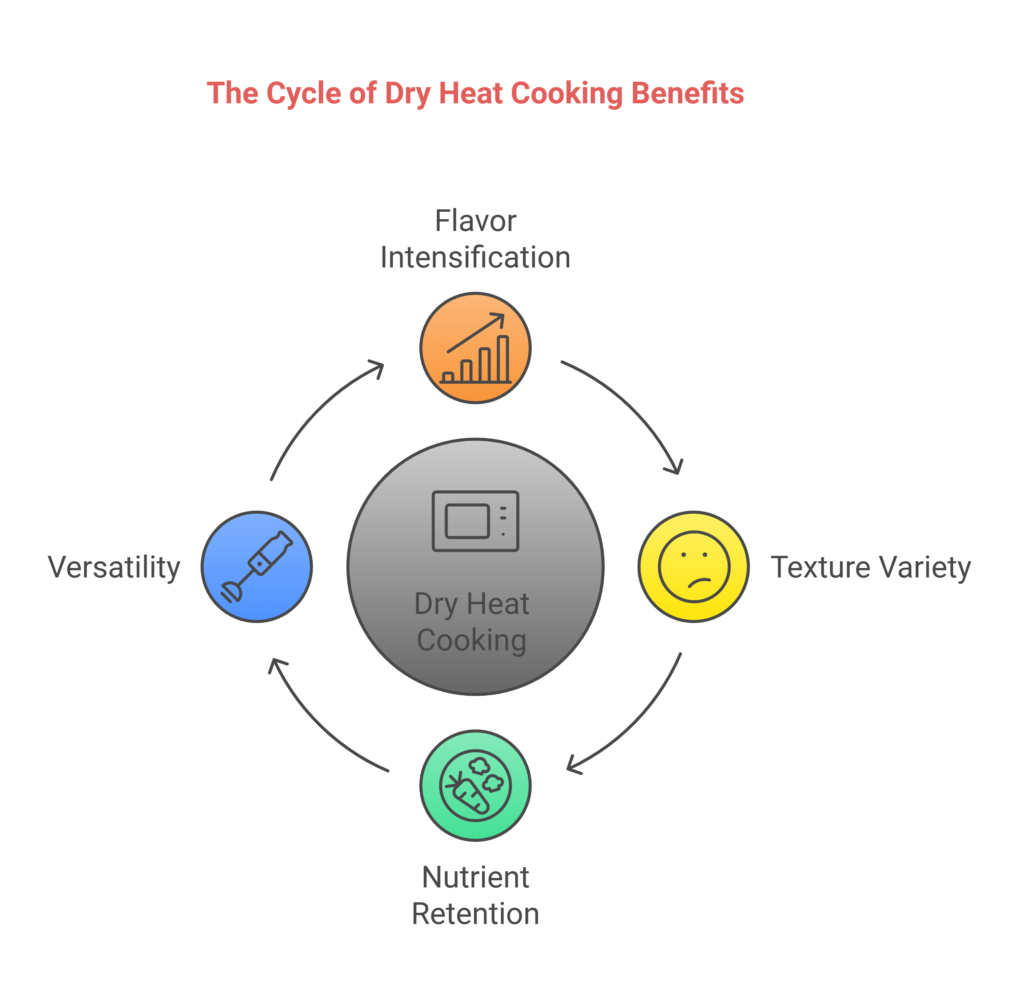
Dry Heat Cooking Techniques
Exploring dry heat cooking techniques can elevate your culinary skills significantly. Each method imparts a unique flavor and texture to food. From the robust aroma of roasting to the crispness of frying, these techniques offer diverse culinary experiences.
Roasting
Roasting involves cooking food in an oven, using consistent dry heat. It works wonders for meats and vegetables. The technique produces a browned, caramelized surface that contrasts with a tender inside.
Key to successful roasting is maintaining the right temperature. High heat helps achieve a crispy exterior. Meanwhile, the inside remains juicy and flavorful.
Ensure to season thoroughly. Spices and herbs infuse deeper into the food’s surface, enhancing the overall flavor profile. Position the food on a rack to ensure even cooking.
Want to master every aspect of this technique? Check out Mastering Roasting Techniques: Your Ultimate Guide to Crispy, Golden Perfection for step-by-step instructions and expert tips.
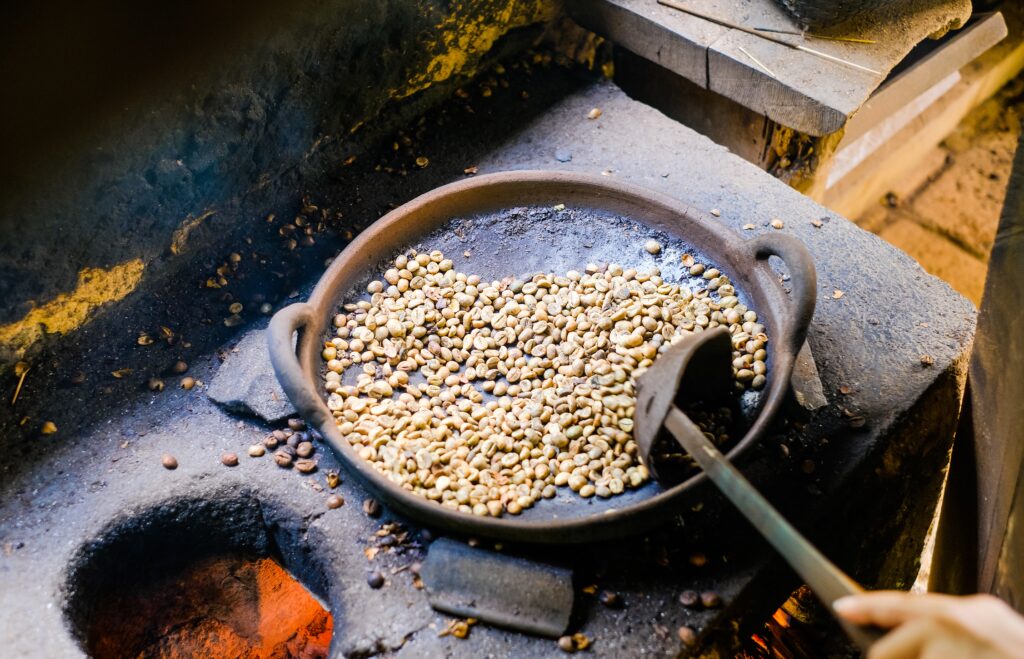
Baking
Baking, similar to roasting, uses oven heat but for different outcomes. It’s predominantly used for bread, pastries, and cakes. This method transforms batter and dough into light, airy creations.
Accurate measurements are crucial. Baking involves precise chemistry. Ingredients react under controlled heat, causing doughs to rise and set.
Preheating the oven ensures even baking throughout the process. This is essential to develop proper texture and structure in baked goods. Pay attention to timing for optimal results.
Looking to deepen your baking skills and perfect every recipe? Check out The Ultimate Baking Technique Guide for detailed tips, troubleshooting techniques, and creative recipes that will take your baking to the next level!
Grilling
Grilling is a popular outdoor method, relying on direct heat from below. It imparts a smoky flavor and creates grill marks on foods. This makes it ideal for steaks, vegetables, and seafood.
Temperature control is vital. Different foods require specific heat levels. High heat quickly sears meats, locking in juices and flavors.
Marinating is often used to enhance flavors before grilling. The combination of ingredients in a marinade can complement the charred, smoky taste typical of grilled foods.
Turn your grill sessions into a culinary adventure with Powerful Grilling Techniques for Smoky, Flavorful Perfection. This guide has everything you need to fire up unforgettable meals.
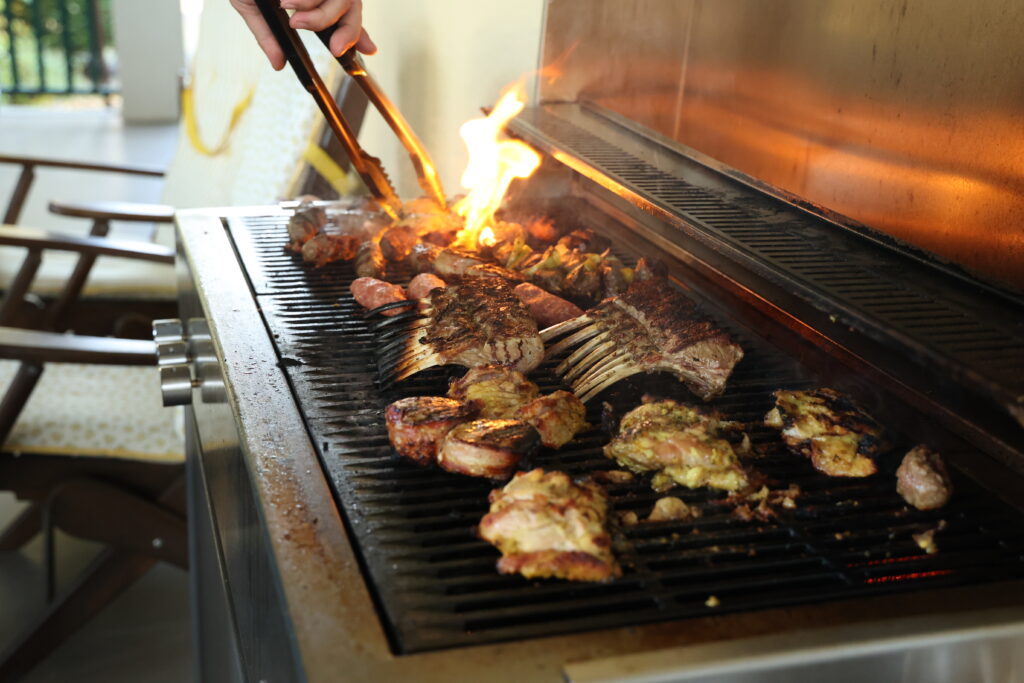
Broiling
Broiling uses high heat from above the food, typically in an oven. It’s similar to grilling but lacks the smoky flavor. This technique is perfect for finishing dishes with a crisp top layer.
Broiling cooks food quickly with intense heat. It suits thin cuts of meat, fish, and vegetables. Keep a close watch to avoid burning, as broiling can easily overheat foods.
A broiler pan can help. It allows fat to drain away, preventing grease fires. This results in a healthier, tastier meal.
Discover more tricks for this quick and dynamic cooking method in The Ultimate Broiling Method Guide: How to Broil Perfect Dishes Every Time. You’ll never look at your oven the same way again!
Sautéing
Sautéing is a quick method using small amounts of oil or fat. It utilizes high heat to brown food rapidly in a pan. This technique is excellent for vegetables, meats, and stir-fries.
Uniform slicing ensures even cooking. Smaller, evenly cut pieces are preferable. This allows them to cook quickly and evenly without burning.
Use a pan with a sturdy base. This promotes even heat distribution and prevents sticking. Stir or toss ingredients frequently for consistent cooking.
Sautéing is both practical and creative. It helps you whip up weeknight meals or serve vibrant sides like seared zucchini or caramelized onions. To master it fully, check out Master the Art of Sautéing Technique: 5 Proven Steps for Perfect Results and elevate your skillet skills!
Frying
Frying relies on submerging food in hot oil. It results in a crispy exterior and a flavorful, tender interior. There are variations like deep-frying and pan-frying, each offering distinct results.
Choosing the right oil is essential. Opt for oils with high smoke points, like vegetable or peanut oil. This prevents off-flavors and smoke during cooking.
Carefully monitor oil temperature. Too hot, and food burns; too low, and it absorbs excess oil. Use a thermometer to ensure precision and safety while frying.
By mastering these dry heat techniques, you open up a world of culinary possibilities. Each method has its place and can enhance your dishes with unique textures and tastes.
Done right, frying creates crispy, light dishes that never feel overly greasy. Want to nail every crispy detail? Visit The Ultimate Guide to Frying Technique: 12 Game-Changing Tips Every Home Cook Must Know to level up your frying game.
Selecting the Right Cookware for Dry Heat Cooking
Choosing the right cookware is essential for effective dry heat cooking. The type of cookware you use impacts heat distribution and cooking results. Opt for materials that ensure even heat transfer for the best outcomes.
Cast iron is a popular choice. Its heavy construction retains heat well, offering consistent temperature control. It’s ideal for searing, sautéing, and even baking.
Stainless steel, known for durability, provides even heat distribution. It’s suitable for various dry heat methods like frying and roasting. Ensure to use pans with heavy bottoms to prevent hotspots.
Non-stick pans are versatile and prevent food from adhering to surfaces. They’re perfect for delicate foods like fish or eggs. However, avoid using them on very high heat to extend their lifespan.
Selecting the right cookware not only improves your cooking but also enhances the flavor and texture of dishes prepared with dry heat methods.
The Importance of Temperature and Timing
Temperature and timing are crucial to mastering dry heat cooking. They ensure your food cooks evenly and thoroughly. Mastering these elements can make the difference between a successful dish and a culinary disappointment.
Each dry heat technique requires specific temperature settings to achieve desired results. High temperatures might be needed for techniques like broiling, while moderate heat suits baking. Understanding these requirements is essential for optimal cooking.
Timing complements temperature by determining when to start and stop cooking. It’s key to prevent overcooking or undercooking. Proper timing enhances flavors and preserves desired textures in your dishes.
To assist with managing temperature and timing, consider the following tips:
- Preheat ovens and pans to stabilize cooking environments.
- Use timers to monitor cooking durations.
- Familiarize yourself with the specific temperature needs of your recipe.
By mastering these aspects, you can enhance your dry heat cooking skills and boost your confidence in the kitchen.
Preheating for Perfection
Preheating is a step often overlooked, but vital in dry heat cooking. Preheating ovens or pans creates a stable cooking environment. It ensures that food starts cooking at the ideal temperature, improving consistency.
Without preheating, food can cook unevenly, affecting both flavor and texture. Cold cookware can result in undercooked centers or overbrowned exteriors. Therefore, always allocate extra minutes for preheating to achieve better results.
The key to effective preheating lies in patience and preparation. Begin preheating while you prep your ingredients. This approach streamlines the cooking process, making it more efficient and less stressful.
Using Thermometers for Precision
Thermometers are indispensable tools in dry heat cooking. They offer precision in managing and monitoring internal food temperatures. This accuracy helps achieve the intended doneness and prevents overcooking.
Use a meat thermometer for thicker cuts of meat. Insert it into the deepest part, avoiding bones for accurate readings. This ensures meats are juicy, safe, and flavorful.
For baking, oven thermometers can verify the actual temperature inside. Ovens sometimes differ from the set temperature, making this tool valuable. Accurate oven readings help maintain consistent baking results.
By utilizing thermometers, you can control cooking outcomes with greater confidence and precision. They are essential for perfecting your dry heat cooking techniques.
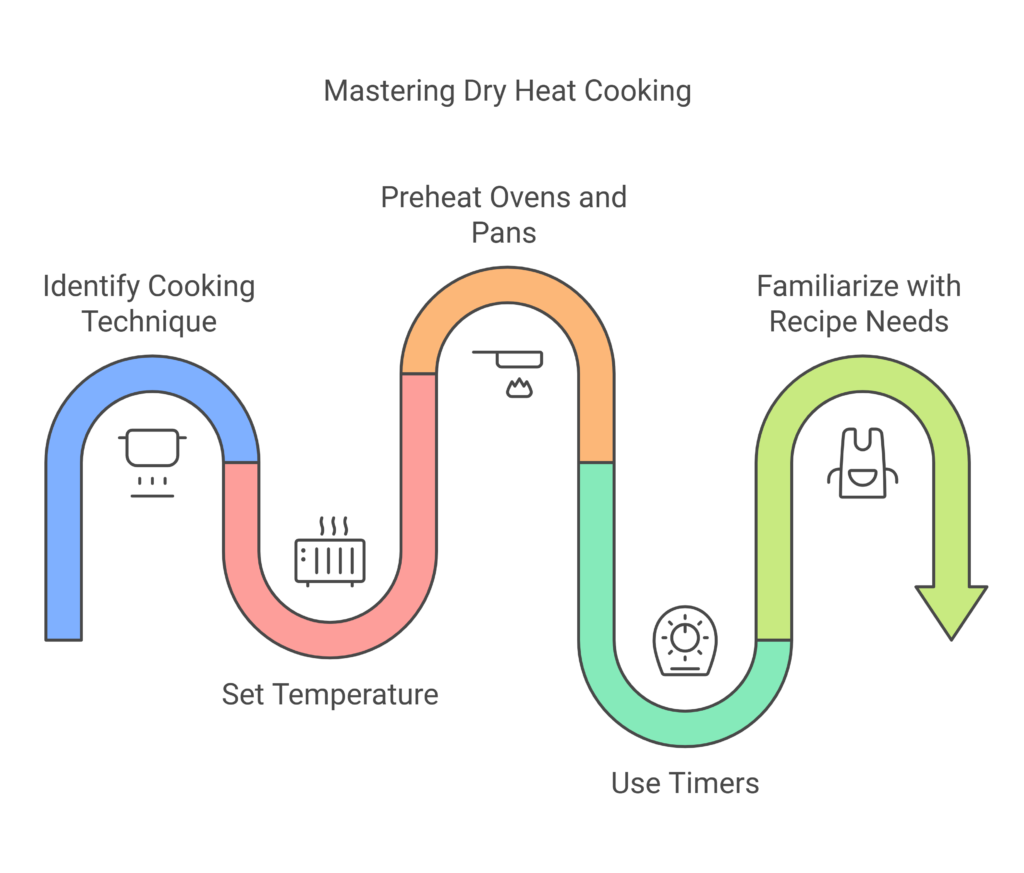
Enhancing Flavors with Dry Heat Cooking
Dry heat cooking can transform basic ingredients into delicious creations. This method plays a significant role in flavor development. Understanding the chemistry behind it can elevate your dishes.
Key chemical processes occur during dry heat cooking that enhance taste and aroma. These include the Maillard reaction and caramelization. They contribute to the complex flavors we associate with browned and roasted foods.
In addition to these processes, the use of marinades, rubs, and seasonings can significantly amplify flavors. They penetrate the surface, infusing food with depth and diversity of taste.
Consider these techniques to enhance your dish:
- Experiment with different spices and herbs.
- Use high-quality oils and fats for richer flavors.
- Allow meats to rest for better flavor distribution.
Through these methods, you can create flavorful, aromatic dishes using dry heat cooking techniques.
The Maillard Reaction and Caramelization
The Maillard reaction is a chemical reaction between amino acids and sugars. It occurs when foods are cooked at high temperatures. This process is responsible for the browning of meat and the nutty flavors of roasted coffee.
Caramelization involves the oxidation of sugar, contributing sweetness and a deep golden color. It’s used in cooking onions, carrots, and dessert toppings. Both processes are essential for developing complex flavors in dry heat cooking.
By understanding and utilizing these reactions, you can better manage flavor profiles. It allows you to create dishes rich in taste and visual appeal.
Marinades, Rubs, and Seasoning
Marinades, rubs, and seasoning are integral to enhancing dry heat cooking. Marinades consist of acidic liquids, herbs, and spices that tenderize and flavor meat. They should be applied in advance to allow absorption.
Rubs are dry mixtures of spices and herbs applied directly to the surface. They create a crust that locks in moisture and adds a flavorful layer. Experimenting with various combinations can yield unique taste experiences.
Seasoning refers to adding salt, pepper, and other flavor enhancers during cooking. Proper seasoning balances flavors and enhances the natural taste of ingredients. It’s essential to taste and adjust during the cooking process.
Incorporating these techniques can elevate your dry heat cooking, bringing complexity and satisfaction to each meal.
Tips and Tricks for Dry Heat Cooking Success
Mastering dry heat cooking requires attention to detail and patience. From selecting the right ingredients to perfect timing, each element contributes to a dish’s success. Being mindful of a few key tips can transform your culinary experience.
Consider the following list of recommendations to enhance your dry heat cooking skills:
- Preheat cookware for better heat distribution.
- Use a meat thermometer to ensure the perfect doneness.
- Allow food to rest before serving to retain juices.
- Keep an eye on temperatures to avoid burning.
- Practice multitasking to manage different cooking stages simultaneously.
By incorporating these practices, you can improve texture and flavors, creating consistently excellent results.
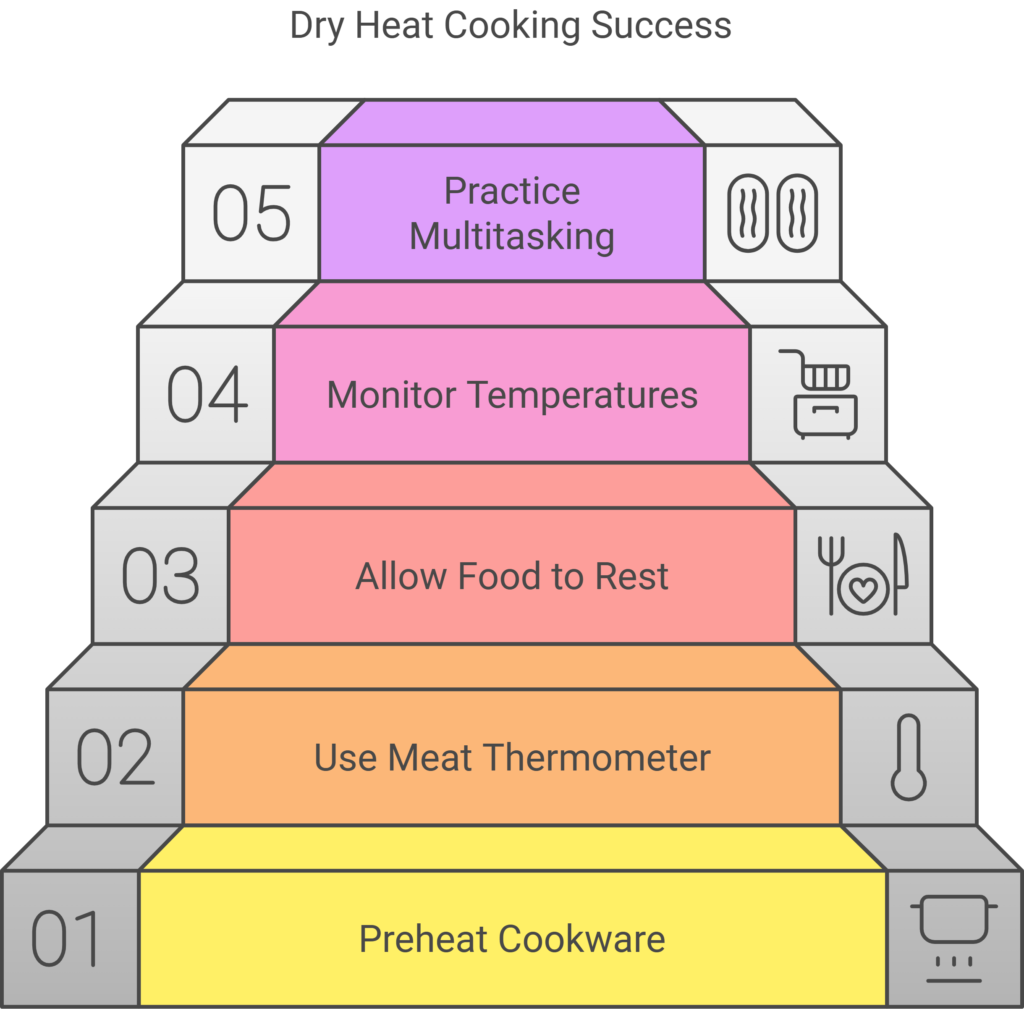
Avoiding Common Pitfalls
Even experienced cooks can encounter challenges with dry heat cooking. Overcooking is a frequent problem, leading to dry or tough dishes. To prevent this, monitor cooking times closely and avoid distractions.
Another common issue is uneven cooking, often caused by improper pan placement or insufficient preheating. Ensure your oven or grill is evenly heated before you begin. Rotate pans as needed during cooking to ensure uniform results.
Understanding these common pitfalls helps you to avoid them, enhancing your cooking outcomes and creating delicious, satisfying dishes.
Cleaning and Maintenance of Dry Heat Cooking Equipment
Keeping your cooking equipment in top condition is crucial for both performance and safety. Regular cleaning prevents food residue buildup that could affect flavor and hygiene. After each use, clean pots, pans, and utensils thoroughly with warm water and mild detergent.
Pay special attention to non-stick cookware to avoid damaging the coating. Use soft sponges instead of abrasive pads. For ovens and grills, routine maintenance ensures even heat distribution and extends their lifespan.
Maintenance not only ensures optimal operation but also improves safety in your kitchen. By caring for your equipment, you enjoy better cooking results and maintain a tidy culinary workspace.
Final Thoughts: The Future of Dry Heat Cooking
Mastering dry heat cooking methods is truly a game-changer in the kitchen. Whether you’re crafting a golden roast, sizzling steak, or a batch of perfectly baked cookies, each technique unlocks new flavors, textures, and opportunities for creativity. These methods aren’t just cooking strategies—they’re the foundation of countless culinary traditions and dishes we love.
If you’re ready to take your skills even further, we’ve got you covered. Explore our individual guides on baking, roasting, grilling, broiling, sautéing, and frying. Each one is packed with tips, recipes, and insights to help you perfect your craft. Start with one or tackle them all—there’s something for every level of cooking expertise.
And now, we’d love to hear from you! What’s your favorite dry heat cooking method? Do you have a go-to recipe or a trick that you swear by? Share your experiences, tips, or questions in the comments section below. After all, the best part of cooking is the joy of learning and sharing it together.
Want to connect with others who love experimenting in the kitchen? Join the conversation on social media! Share your cooking creations, handy tips, or burning questions with the hashtag #DryHeatCooking and tag us @roastedkitchen25 on instagram. Whether it’s a perfectly grilled steak or a baking success story, we can’t wait to see what you’ve been whipping up.
Follow us on Instagram, Facebook, and X for even more cooking tips, recipe inspiration, and behind-the-scenes fun. Don’t forget to subscribe our newsletter. Together, we’ll keep the creativity (and deliciousness) flowing. Happy cooking!
FAQs About Dry Heat Cooking
What is dry heat cooking?
Dry heat cooking involves cooking food using air or fat without adding moisture. Techniques like grilling, roasting, and sautéing fall under this method, focusing on enhancing flavors through direct heat.
How does dry heat cooking differ from moist heat cooking?
Dry heat methods use high temperatures to brown and create textures, while moist heat techniques use liquids or steam for tenderizing. The results are different in both texture and flavor profiles.
What are the benefits of using dry heat cooking?
This method highlights the natural flavors of ingredients and creates appealing textures. Foods cooked with dry heat often have enhanced caramelization and Maillard reactions, adding depth to dishes.
Which cookware is best for dry heat cooking?
Choosing the right cookware is crucial. Cast iron, stainless steel, and heavy-duty baking sheets excel in heat retention and even cooking. Non-stick options suit methods like sautéing to minimize sticking.
Additional tips for success in dry heat cooking:
- Preheat cookware for even cooking.
- Use thermometers for precise temperature control.
- Season adequately to enhance flavor.
- Practice safety with high heat to avoid burns.
- Allow the meat to rest for improved texture.
Understanding these aspects ensures successful and flavorful dry heat cooking experiences.

Hi, I’m Mayaz Ahsan!
As a passionate cook, storyteller, and food enthusiast, I combine my love for travel, farming, reading, and teaching to bring you insightful culinary tips and stories. Welcome to Roasted Kitchen – I’m thrilled to share this journey with you!










 Subscribe to our free newsletter for tips, tutorials, and insights!
Subscribe to our free newsletter for tips, tutorials, and insights!